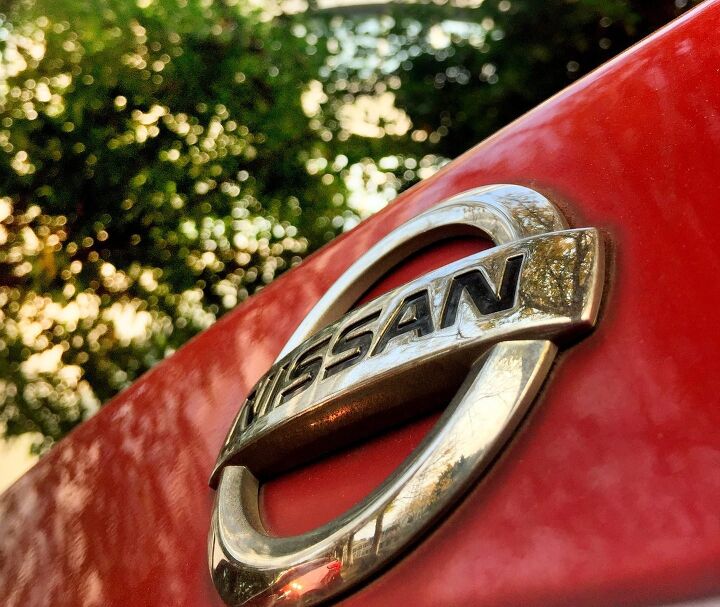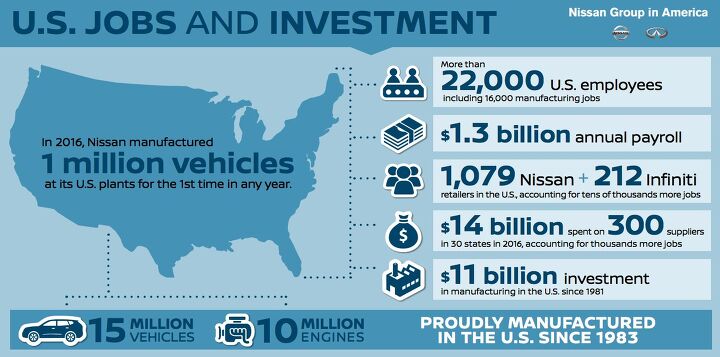Nissan Mulls Extra U.S Manufacturing Capacity

Earlier this year, the big bosses at Nissan expressed their desire to grab a full 5 percent of pickup truck market share in the United States. However, chasing arbitrary targets has now fallen in favor of smart growth.
Still, lighting a fire under the brand seems to have worked, with Nissan moving nearly 1.5 million units in 2016, almost a million more annual sales than 15 years ago. With those numbers in mind, the company is acknowledging it’ll soon need a new assembly plant in America.
According to the Japan Times, Jose Munoz, chairman of Nissan North America since 2014, stated, “At some point, we may need it,” referring to additional U.S. production capacity. There’s an excellent chance that any extra capacity would have to come from a new facility, since the plants in Tennessee and Mississippi are currently running at capacity.
The two Nissan assembly facilities in America crank out a bevy of high-volume products. In addition to a couple of other models, the Tennessee plant makes the strong selling Rogue and three-row Pathfinder. In Mississippi, Nissan hosts Titan production, along with that of the Frontier and Murano. That facility has an annual production capacity of 450,000 vehicles, and Nissan’s Mississippi workforce has assembled more than three million vehicles since opening the site in 2003. The Tennessee plant employs 8,400 workers and has an annual capacity of 640,000 vehicles. (The Altima and new Leaf are built stateside as well.)
Going forward, Nissan has committed to building the next-gen Frontier at the same plant where the present truck is being assembled, meaning that any new production will likely add to, not replace, current manufacturing numbers in America. The Mississippi plant employs more than 6,000 workers and, according to a 2016 study by Mississippi State University, the facility has generated 25,000 direct and indirect jobs statewide. Numbers such as these would no doubt be welcome in any manufacturing town across America.
Nissan sold its first automobile in the U.S. in 1958, with U.S. manufacturing starting in June of 1983 as a white Nissan pickup truck rolled off the assembly line at a brand new plant in Tennessee. Now, Nissan has U.S. manufacturing facilities capable of producing 1.14 million vehicles and 1.5 million engines annually. A new facility would only add to those totals.
Now, I’m posting pictures of the ’97 Pathfinder and Frontier because a) they’re wonderful and b) Nissan has an archive of official photos stretching back to 1997. My productivity may suffer for the next 30 minutes.
[Images: Nissan]

Matthew buys, sells, fixes, & races cars. As a human index of auto & auction knowledge, he is fond of making money and offering loud opinions.
More by Matthew Guy
Latest Car Reviews
Read moreLatest Product Reviews
Read moreRecent Comments
- ToolGuy "I have my stance -- I won't prejudice the commentariat by sharing it."• Like Tim, I have my opinion and it is perfect and above reproach (as long as I keep it to myself). I would hate to share it with the world and risk having someone critique it. LOL.
- SCE to AUX Sure, give them everything they want, and more. Let them decide how long they keep their jobs and their plant, until both go away.
- SCE to AUX Range only matters if you need more of it - just like towing capacity in trucks.I have a short-range EV and still manage to put 1000 miles/month on it, because the car is perfectly suited to my use case.There is no such thing as one-size-fits all with vehicles.
- Doug brockman There will be many many people living in apartments without dedicated charging facilities in future who will need personal vehicles to get to work and school and for whom mass transit will be an annoying inconvenience
- Jeff Self driving cars are not ready for prime time.





































Comments
Join the conversation
He's flooding the market w/ lower level stuff because he knows some buy purely on price. There's Toyota, Honda and Mazda and then there's Nissan, below Hyundai and Kia.
Mitsubishi Normal Illinois Assembly plant would have been inexpensive and appropriate to expand Nissan manufacturing. Rivian Automotive purchased it. Perhaps Nissan-Mitsubishi could buy it back.